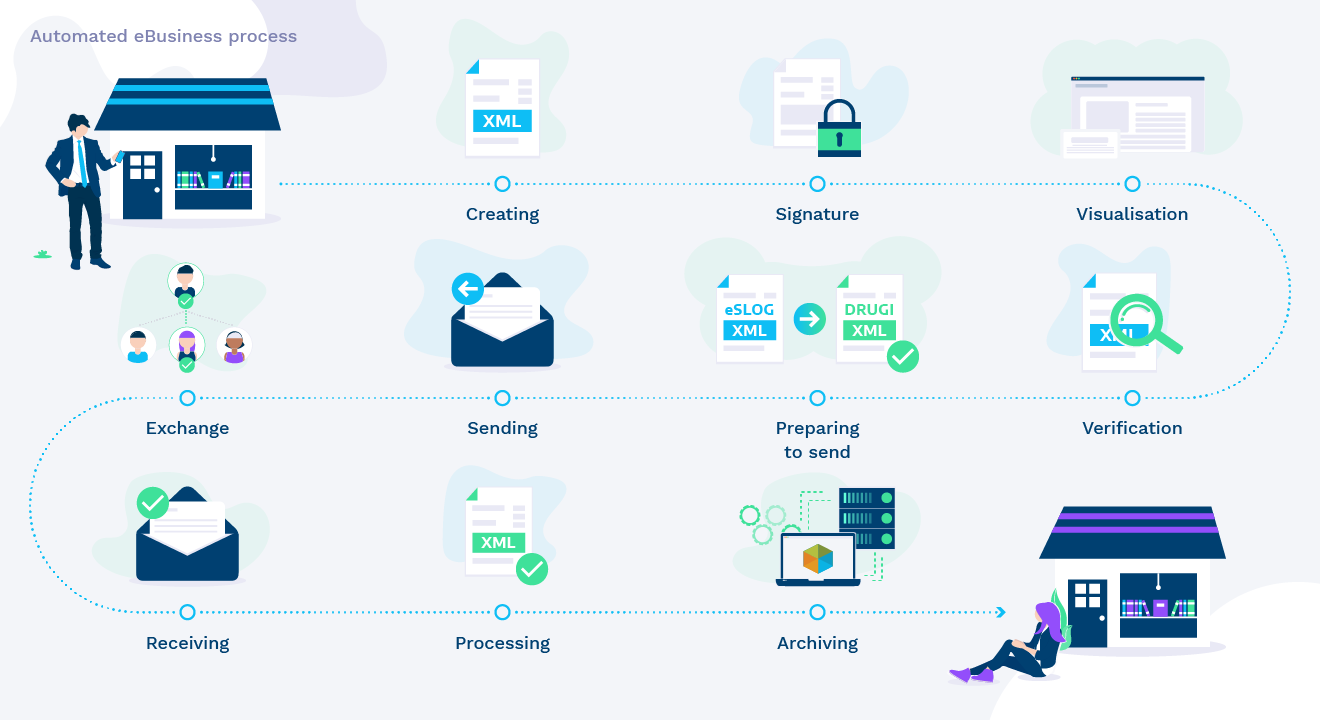Supporting services
In Slovenia, it is mandatory that eInvoices in B2G and G2G are sent through the PPA eInvoicing system. eInvoices can be transmitted by economic operators through different channels (such as web-services, a dedicated web-portal, etc.) and by using different market solutions. The vast majority of eInvoices in Slovenia are exchanged via eInvoicing networks providers. BizBox network and Bankart Banks Network are the main eInvoicing solution providers used by public entities and economic operators in Slovenia.
eInvoices can be created in accounting software solutions, through web portals or dedicated tools (e.g. Excel).
Electronic signing using a digital certificate is recommended. Signing is often available within eInvoice creation solutions, and dedicated electronic signature tools can also be used.
Normally, in addition to the XML invoice, its visualization in PDF or another format is also attached for easier processing of the invoice. The visualization can be prepared within eInvoice creation solutions, but various online tools can also be used to create the visualization from an XML format invoice.
Invoice verification tools can be used to verify the structure and business rules of an eSLOG invoice. This way, the issuer can verify that the invoice is eligible for sending before it is sent out.
If the format of the created eInvoice is different from the format accepted by the recipient, the eInvoice must be converted to the appropriate target format. This can be done by the issuer, the exchange provider or the recipient.
Before sending, the XML eInvoice must be equipped with a digital envelope containing addressing information similar to a paper invoice envelope. The envelope is usually prepared by an eInvoice creation software solution or the solution provider.
Sending is usually done by eExchange service providers who ensure secure and reliable delivery (much like the postal services with paper invoices). Sending out eInvoices via email is not recommended because it is not secure and reliable enough.
Most accounting programs already have one or more eExchange providers integrated for this purpose, allowing the issuer to send out prepared eInvoices quickly and easily.
If the format of the created eInvoice is different from the format accepted by the recipient, the eInvoice must be converted to the appropriate target format. Most often, the transformation of an eInvoice, if necessary, is done by the eExchange provider during transfer of the eInvoice from the issuer to the recipient.
Providers of eExchange who ensure secure and reliable delivery allow eInvoices to be exchanged between users on their network. An increasing number of eExchange providers also connect to each other, thus allowing the eInvoices to be exchanged between the issuer and the recipient, even if the two are not connected to the same provider.
The recipient receives the eInvoice from their eExchange provider in a manner previously agreed. Most accounting programs already have one or more eExchange providers integrated for this purpose, allowing the issuer to send out eInvoices quickly and easily.
If the format of the eInvoice received is different from the format supported by the recipient’s program, the recipient must convert the eInvoice to the appropriate format before importing it.
Most accounting programs allow for automatic import of data from an eInvoice into the program, so there is no need of entering the invoice manually. When importing, the program can also verify that the invoice is valid (structure, content, signature).
The company performs the processing (posting, liquidation, etc.) of the invoice in accordance with its procedures.
According to the Value Added Tax Act (ZDDV-1), copies of invoices issued and received must be stored for ten years after the end of the year to which the invoices relate, or 20 years if the invoices relate to real estate. The eInvoice must be stored in eSLOG XML format, and it is recommended that it be stored along with the visualization of the invoice in PDF format.
The invoice can be stored by the company or it can use the services of different providers. Some eExchange providers also offer the option of storing exchanged invoices as an additional service.
The Protection of Documents and Archives and Archival Institutions Act (ZVDAGA) also sets out the terms and conditions which an eArchiving service provider must meet in order to be able to certify its service and thus make it more credible for businesses.
To help make a decision, a catalogue of services and tools which support eInvoicing is available.



